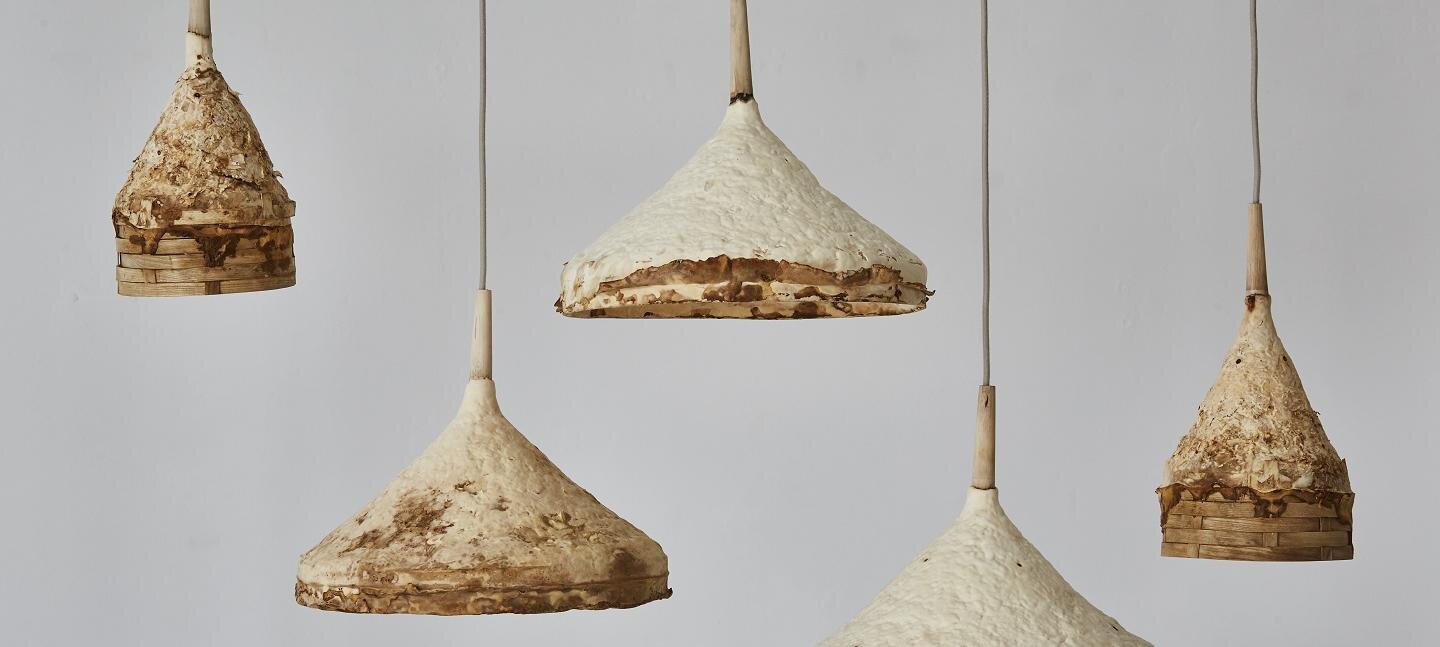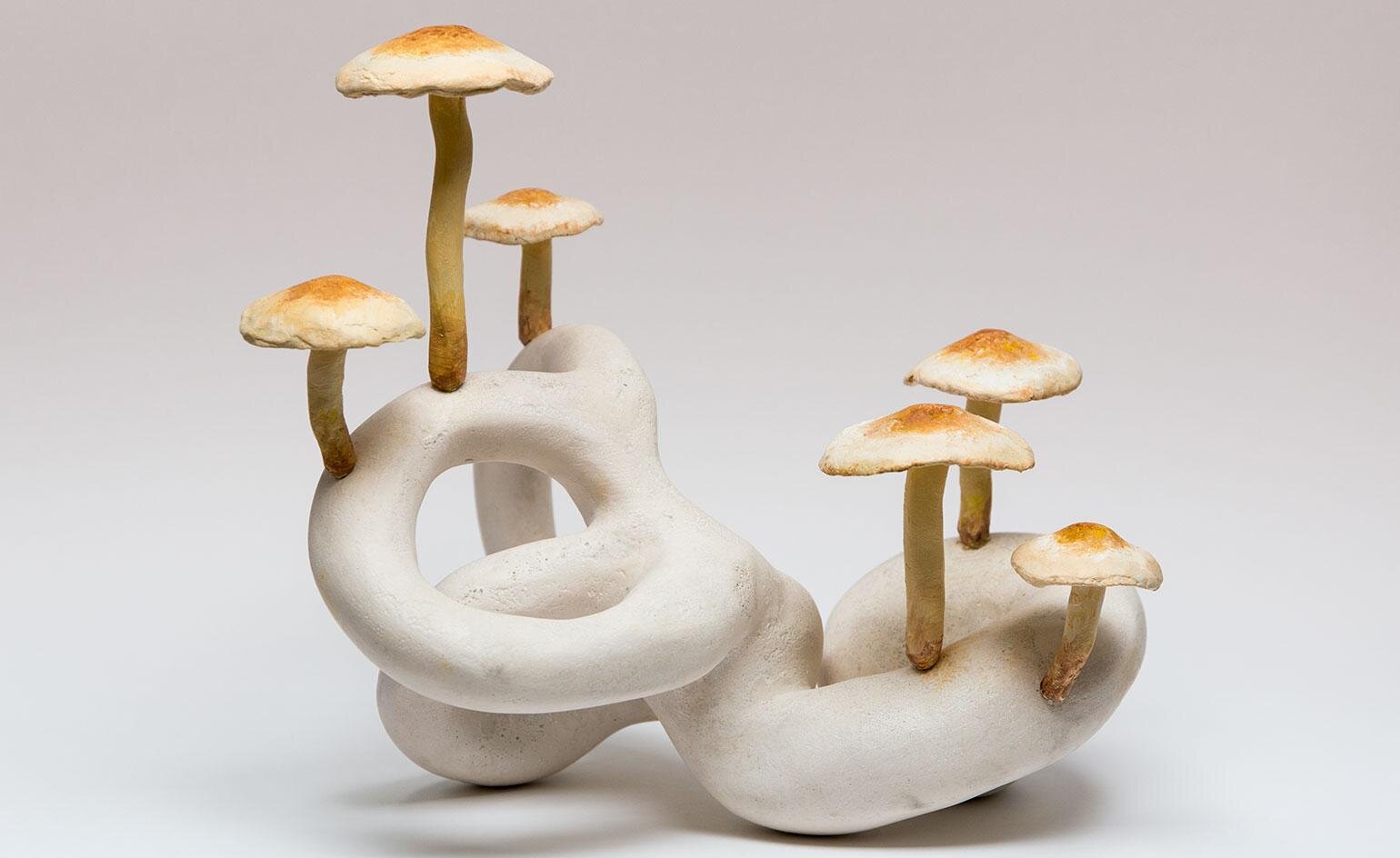Curator’s Focus on
Alternative Materials
Alternative materials within the contemporary craft and design sector pave way for an intersection of disciplines; from a conceptual craft practice, towards a purpose fuelled design economy. When the manufacturing process of materials can cause harmful effects on the environment, the use of alternative materials can open the possibility for a circular design narrative.
The use and application of alternative materials can allow access for products to be reused, repurposed or recycled. Established London based furniture designer, Sebastian Cox, here, discovers the wonders of mycelium. An exhibition which really caught my eye was Somerset House’s, Mushrooms: the art, design and future of fungi curated by Francesca Gavin. Showcasing an eclectic range of artists and designers celebrating mycelium in all its forms, this particular piece was conceived in collaboration with design strategist Ninela Ivanova to offer new ideas for design fabrication calling question to product aesthetics and material properties. Who knew the humble mushroom could offer so many possibilities within design!
Sebastian Cox & Ninela Ivanova mycelium & Timber lamp



Mushrooms: The art, design and future of fungi | Somerset House
Textile-like biofilm of P. roqueforti (Park & Ivanova, 2013). Image courtesy of Dr Simon Park
Image taken from Ninela Ivanova
Pine Skins Artwork | Visit artist profile HERE
November 2019 Cluster Crafts exhibitor, Carolyn Raff highlighted her project “An ocean full of opportunities” with us. With a focus on sustainability and material research, the work pushes the boundaries of agar algae in the context of fashion design. Over recent weeks, she has begun testing with hibiscus creating a stunning array of colour profiles and material tests. As much as algae is becoming more widely tested within the design sector, further work is needed within the field to develop the application of such materials at scale
Carolyn Raff | Open Cell
Collaboration between sectors and industries is a key aspect to tackling the climate crisis in regards to mass product consumption. Cross promotion of ideas, design methodologies and knowledge aids the development for alternative ideas and materials such as these to shine.
From an outward approach, we return to our Cluster Craft exhibitors working with alternative materials. We start with Sarmite Polakova, graduating from the Design Academy Eindhoven as a material researcher and designer. Her ongoing project, ‘Pine Skins’ will launch a new body of work at Cluster Crafts upcoming exhibition in September. From a material widely recognised, Polakova re-invents the use of Pine Bark as a product to be used within the home. Her practice embodies the ‘future’ of craft. It contains the essence of the growing movement that design holds; conceptual, yet with an outward facing approach on themes surrounding sustainability. Material innovation such as this broadens our outlook, aiding society to really ‘think’ about their impact as a consumer.
Carolyn Raff | Open Cell
Carolyn Raff | Open Cell
At our upcoming September Edition, Central Saint Martins course, ‘Material Futures’ will launch this year's MA cohort of material designers and innovators. Cluster this year inviting institutions to join our community and open up the discussion towards alternative materials and innovators of the future. This way, presenting craft not only for the realm of aesthetics, but also for a deepening of material understanding and appreciation of process itself.
Yiwei Cui | CSM MA Material Futures | Image ARTS THREAD
CRAFTING PLASTICS! studio brings bioplastics into our day-to-day life. We experiment, produce and collaborate while having the whole product’s lifecycle in mind.
Within the context of alternative materials, we return to a few of my highlights. Berlin based design studio, Crafting Plastics, exhibitors at Beazley Design of the Year, brings bioplastics into our day-to-day life. Their company ethos embodies a circular design narrative, with the full lifecycle of the product in mind. Alongside their extensive material research concepts, their interdisciplinary approach provides a place to share ideas across sectors. Most recently, they have formed COVID COLAB, a ‘platform for participatory design interventions’ in light of the climate situation; allowing young designers and innovators to get involved to support society through design innovation.
As much as material innovation is key for the future of design, how we come to share these ideas is as important. The Restoration Collective looks to ‘keep craft alive’ by connecting the public with skilled crafts makers, not only shining a light on their material knowledge, but also linking education, encouraging schools to include craft practices within their curriculum. This also aids in the development of a circular design narrative, and one where knowledge is both gained and appreciated. It follows the same message as often the way with alternative materials to provide a design solution to a greater problem. It looks to preserve the beauty of craft practices, whilst looking outwardly to the future in the context of restoration. Launching this summer 2020, check out their profile for further updates.
Lastly, but by no means least, those of you within the creative sector, many of you will already be aware of design researcher Seetal Solanki, author of “Why Materials Matter”. A fabulous book detailing a wide plethora of material designers stretching the possibilities and use of alternative materials; from James Shaw’s cartoon-esque plastic extrusions, to salt and mineral sculptor, Erez Nevi Pana, it offers a true delight of material discovery that I really recommend.
To conclude, as wide as the topic of alternative materials is, it’s becoming a topic society is increasingly aware of. Simply looking towards the negative impact design can have on the environment, the use of alternative materials, particularly those sourced within nature; not only opens the public's mind to the possibilities that materials can hold, but in doing so, widens material understanding and knowledge. This growth in knowledge along with innovation, truly in my opinion is what’s needed to continue to edge towards a circular economy. Here I have touched upon the cross over between craft and design within alternative materials; exploring the work of Cluster Crafts exhibitors alongside key industry leaders within the field. I hope this has offered some insight for you as to the wonders and possibilities alternative materials can hold and inspire you to continue the journey of material understanding and discovery along your own path.
Thank you for reading,
Lucy Swift





